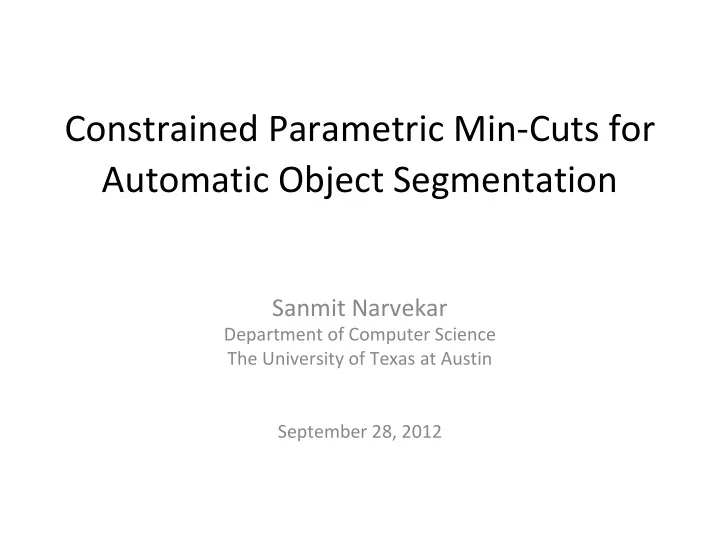

Constrained Parametric Min-Cuts for Automatic Object Segmentation Sanmit Narvekar Department of Computer Science The University of Texas at Austin September 28, 2012
Outline • Introduction • Method Overview • Phase I: Generate Pool of Segments • Phase II: Rank Segments • Experiments • Analysis • Conclusion
Image credit: Carreira & Sminchisescu (PAMI 2012) Object Segmentation Object Object Object Object
Image credit: Carreira & Sminchisescu (PAMI 2012) Object Segmentation
Approaches “Traditional” Way CPMC Way VS Image credit: Silberman et. al. (ECCV 2012) Image credit: Carreira & Sminchisescu (CVPR 2010)
Method Overview Phase I: Generate a pool of foreground segments using Constrained Parametric Min-Cuts Phase II: Rank the segments by learning a random forest regressor Image credit: Carreira & Sminchisescu (CVPR 2010)
Phase I Main Idea : Generate a pool of foreground segments 1. Seed the image-graph with foreground and background seeds 2. Map the image onto a weighted graph 3. Solve the CPMC optimization objective 4. Repeat 1 – 3 with varying seeds and parameters Image credit: Carreira & 5. Filter initial candidates with fast rejection Sminchisescu (CVPR 2010)
Seeding Policy • Foreground seeds – 5x5 grid approach • Background seeds – Seed along image border – Vertical edges on border – Horizontal edges on border – All but bottom edge Image credit: Carreira & Sminchisescu (CVPR 2010)
Mapping onto a Weighted Graph • Map the image onto a weighted graph where: – Nodes are pixels – Weighted edges represent similarity between pixels – Add 2 special nodes: one to foreground, one to background Image credit: Boykov & Jolly (ICCV 2001)
Optimization Objective • We want to design a function such that High “energy” for bad labelings Low “energy” for good labelings (note this will encode Input space is X, a our biases of what is labeling of all pixels good and bad) in the image MINIMIZE
Optimization Objective MINIMIZE Penalize on the node-pixel assignment Determines “foreground bias” No penalty for labeling as foreground Prevent labeling background nodes as foreground, and vice versa Penalizes for labeling as background (controls degree of foreground bias) Uniform bias (λ everywhere) Supplement with color term based on color distributions
Optimization Objective MINIMIZE Penalize assigning different labels to “similar” neighbors Adjacent pixels are usually in the same class, so no penalty Different labels – penalize based on similarity Measures similarity between u and v is the contour detector from Arbelaez et. al. Image credit: Photoshop Essentials
Constrained Parametric Min Cuts (CPMC) MINIMUM Equivalent to min-cut on graph Image credit: Boykov & Jolly (ICCV 2001)
Fast Rejection • Now we have about 10,000 candidate segments! – Need to eliminate some: Cluster using overlap, and Remove small segments Sort by ratio cut, and keep lowest energy segment (less than 150 pixels) keep top 2000 in each cluster • Only around 150 candidates left Image Credit: Carreira & Sminchisescu (CVPR 2010), Wang & Siskind (PAMI 2003), Mathworks
Phase II Main Idea : Machine learn which segments are good (i.e. rank them) 1. Generate features that could describe “good” segments 2. Train a Random Forest 3. Diversify the rankings Image credit: Carreira & Sminchisescu (CVPR 2010)
Segment Features • Graph Partition Properties (8) – Common for segmentation • Region Properties (18) – Location and scale of objects • Gestalt Properties (8) – Mid-level cues (e.g. continuity) Graph credit: Carreira & Sminchisescu (CVPR 2010)
Random Forest Regression • Non-linear model that uses several regression High Rank trees Image credit: Carreira & Sminchisescu (CVPR 2010) • We maximize the pixel-wise overlap between a segment S, and the ground truth G. • Penalizes on over-segmenting and under- segmenting Low Rank
Maximal Marginal Relevance (MMR) • Rankings returned by Random Forests put similar segments together • MMR diversifies the rankings – After the top segment, each subsequent segment is the original score minus a redundancy measure (the overlap) Image credit: Carreira & Sminchisescu (PAMI 2012)
Experiments • Weizmann’s Segmentation Evaluation Database – 100 grayscale images – One prominent foreground object in each Image credit: Carreira & Sminchisescu (CVPR 2010)
Experiments • Microsoft Research Cambridge Dataset v2 (MSRC) – 591 color images, 23 classes – Evaluated as pool of segments, not individual rankings N : # pixels in the image |R|: # pixels in ground truth Image credit: MSRC
Experiments • Visual Object Challenge (VOC) 2009 – 3000 color images, 20 classes – Evaluated as pool of segments, not individual rankings N : # pixels in the image |R|: # pixels in ground truth Image credit: Carreira & Sminchisescu (CVPR 2010)
Analysis • Strengths – Gives multiple possible foreground segments and their scores – More likely to represent an object using less segments • Weaknesses – Very small objects – Seeding density and hollow objects – Partially occluded objects – Only “grows” one foreground segment at a time – Computationally expensive (too many cuts) Image credit: Carreira & Sminchisescu (CVPR 2010, PAMI 2012)
Conclusions • Comparison to related work – Arbelaez et. al. – Silberman et. al. • Extensions – Multiple object segmentation – Applied to object recognition, perhaps in an unsupervised, active setting
Questions?
Recommend
More recommend